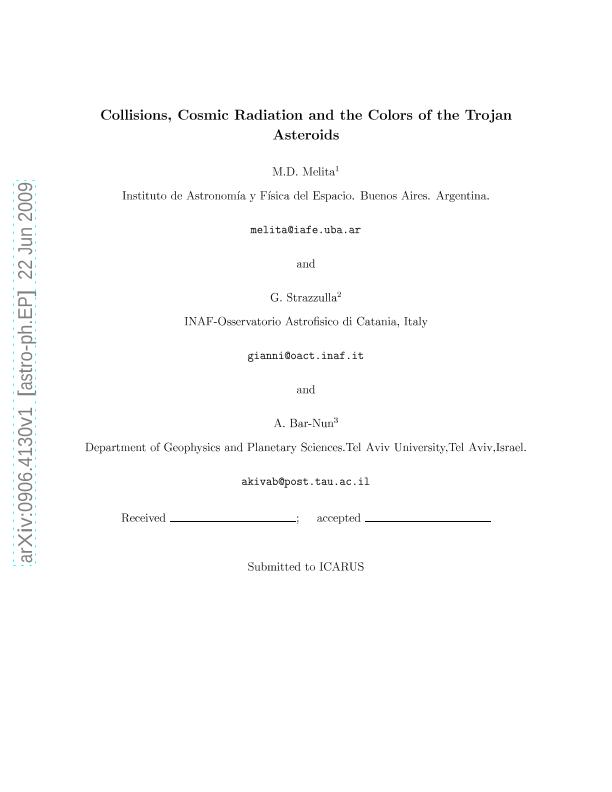Mostrar el registro sencillo del ítem
dc.contributor.author
Melita, Mario Daniel

dc.contributor.author
Strazzulla, G.
dc.contributor.author
Bar Nun, A.
dc.date.available
2017-07-14T17:13:39Z
dc.date.issued
2009-04
dc.identifier.citation
Melita, Mario Daniel; Strazzulla, G.; Bar Nun, A.; Collisions, Cosmic Radiation and the Colors of the Trojan Asteroids; Academic Press Inc Elsevier Science; Icarus; 203; 1; 4-2009; 134-139
dc.identifier.issn
0019-1035
dc.identifier.uri
http://hdl.handle.net/11336/20573
dc.description.abstract
The Trojan asteroids orbit about the Lagrangian points of Jupiter and the
residence times about their present location are very long for most of them.
If these bodies originated in the outer Solar System, they should be mainly
composed of water ice, but, in contrast with comets, all the volatiles close to the
surface would have been lost long ago. Irrespective of the rotation period, and
hence the surface temperature and ice sublimation rate, a dust layer exists always
on the surface. We show that the timescale for resurfacing the entire surface of
the Trojan asteroids is similar to that of the flattening of the red spectrum of
the new dust by solar-proton irradiation. This, if the cut-off radius of the size
distribution of the impacting objects is between 1mm and 1m and its slope is -3,
for the entire size-range. Therefore, the surfaces of most Trojan asteroids should
be composed mainly of unirradiated dust
dc.format
application/pdf
dc.language.iso
eng
dc.publisher
Academic Press Inc Elsevier Science

dc.rights
info:eu-repo/semantics/openAccess
dc.rights.uri
https://creativecommons.org/licenses/by-nc-sa/2.5/ar/
dc.subject
Asteroids
dc.subject
Solar System Origin
dc.subject
Comets
dc.subject
Minor Planets
dc.subject.classification
Astronomía

dc.subject.classification
Ciencias Físicas

dc.subject.classification
CIENCIAS NATURALES Y EXACTAS

dc.title
Collisions, Cosmic Radiation and the Colors of the Trojan Asteroids
dc.type
info:eu-repo/semantics/article
dc.type
info:ar-repo/semantics/artículo
dc.type
info:eu-repo/semantics/publishedVersion
dc.date.updated
2017-07-14T14:08:13Z
dc.journal.volume
203
dc.journal.number
1
dc.journal.pagination
134-139
dc.journal.pais
Países Bajos

dc.journal.ciudad
Amsterdam
dc.description.fil
Fil: Melita, Mario Daniel. Consejo Nacional de Investigaciónes Científicas y Técnicas. Oficina de Coordinación Administrativa Ciudad Universitaria. Instituto de Astronomía y Física del Espacio. - Universidad de Buenos Aires. Facultad de Ciencias Exactas y Naturales. Instituto de Astronomía y Física del Espacio; Argentina
dc.description.fil
Fil: Strazzulla, G.. Osservatorio Astrofisico di Catania; Italia
dc.description.fil
Fil: Bar Nun, A.. Tel Aviv University; Israel
dc.journal.title
Icarus

dc.relation.alternativeid
info:eu-repo/semantics/altIdentifier/url/https://arxiv.org/abs/0906.4130
dc.relation.alternativeid
info:eu-repo/semantics/altIdentifier/url/http://www.sciencedirect.com/science/article/pii/S0019103509001894
dc.relation.alternativeid
info:eu-repo/semantics/altIdentifier/doi/http://dx.doi.org/10.1016/j.icarus.2009.04.024
Archivos asociados
